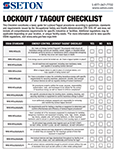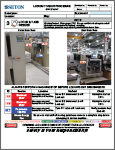
Lockout procedures are critical safety practices
Implementing lockout safety procedures in your workplace are critical, especially in industries involving heavy machinery and equipment. According to OSHA, failing to control hazardous energy results in nearly 10% of the serious workplace accidents in various industries throughout the country. Lockout tools such as padlocks and safety hasps prevent machines from being powered on while under repair or out of order, while the addition of mandatory lockout tags is crucial in identifying the authorized personnel in charge of the equipment. Following proper lockout procedures can save the lives of workers working on or near lockout machinery.
These digital resources are available for Lockout/Tagout:

|

|
|
|
|
|
Padlocks
Padlocks are one of the most essential and versatile tools for any lockout procedure. Working in conjunction with the appropriate lockout device, padlocks can secure anything from circuit breakers to power plugs. Choose from keyed alike, keyed differently and master keyed manufactured by trusted brands in the lockout industry.
Lockout Devices
In order to adequately comply with federal lockout/tagout regulations, lockout devices are an important factor for effective energy hazard protection. The regulations highlight the employer’s responsibility to protect workers from hazardous energy sources, Seton offers a wide range of lockout devices to help you develop a safety program best suited to your facility.
Cabinets and Stations
Maintenance procedures can easily become a hazard without the proper safety equipment such as lockout cabinets to help prevent energy and start up accidents. Lockout stations are a key piece of equipment in keeping workers safe on the job by ensuring the necessary tools are safe, secure and available when needed.
Group Lock Boxes
Secure and organize your lockout/tagout tools with a multipurpose group lockbox made from durable materials, Seton’s boxes can protect both small and large tools under any condition or environment. These devices are designed to serve multiple functions such as providing energy isolation solutions by limiting the weight on each energy point, reduce the amount of locks needed on a job and identify which workers are still working on each energy source.
Lockout Training
Lockout training is an important safety measure in ensuring proper OSHA regulation compliance and preventing electrical and equipment accidents from occurring in the workplace. Too often workers are injured or killed due to powered up machines mistaken for being off or improperly powered-down equipment proper training on safety procedures can reduce this risk.
Lockout Kits
The success of a lockout/tagout procedure depends on the proper use of safety devices including lockout kits. These kits fill an important role in the overall safety of employees by keeping lockout tools secure and handy.
Lockout Tags
Lockout tags are a crucial part of a lockout/tagout procedure to prevent employees from accidentally powering up equipment and machinery while complying with OSHA regulations. Seton offers various tag options including heavy duty, lock-on, padlock and bilingual styles.
Lockout Signs
Keep workers reminded about proper lockout procedures and the importance of safety with lockout signs. From signs that withstand extreme conditions and chemicals, write-on signs and magnetic signs Seton has you covered.
Lockout Labels
Lockout labels hep prevent incidents that can cause serious injuries and incur legal fines and penalties by reminding employees to secure equipment that is a likely source of hazardous energy.
Lockout Procedure Services
Procedures are an important safety measure when isolating equipment from energy sources.View a sample of our standardized Lockout Procedure template, to utilize this template and create your own procedures.




